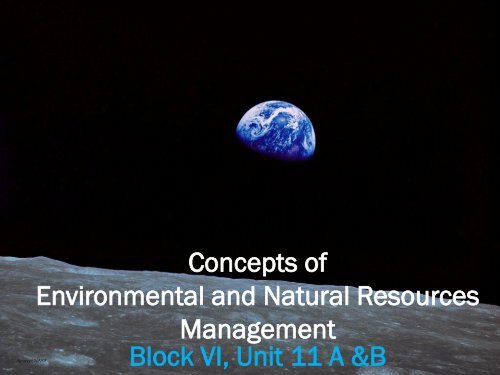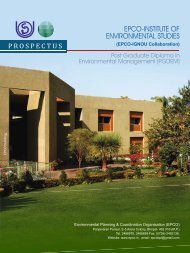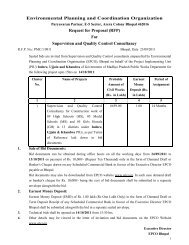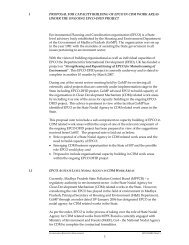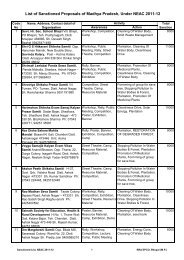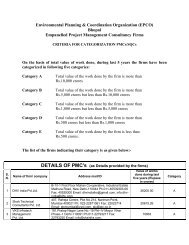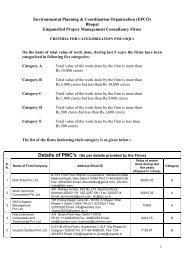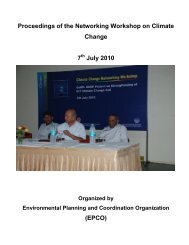Environmental resource management - EPCO
Environmental resource management - EPCO
Environmental resource management - EPCO
- No tags were found...
You also want an ePaper? Increase the reach of your titles
YUMPU automatically turns print PDFs into web optimized ePapers that Google loves.
Source: NASAConcepts of<strong>Environmental</strong> and Natural ResourcesManagementBlock VI, Unit 11 A &B
Definition• The biophysical environment isthe biotic and abiotic surrounding of an organisms, or population,and includes particularly the factors that have an influence in theirsurvival, development and evolution.• The scope of the biophysical environment is all that contained inthe biosphere, which is that part of the Earth in which all life occurs.• A biophysical environment is the complex of biotic, climatic, andedaphic factors that act upon an organism and determine its formand survival, and morphs itself in the process.• The biophysical environment can vary in scale from microscopic toglobal in extent. They can also be subdivided according to theirattributes like marine environment, the atmosphericenvironment and the terrestrial environment.
Life/environment interaction• Life has to be adapted to its environment conditions.• Temperature, light, humidity, soil nutrients, etc, all this has aninfluence in the species that can inhabit a particular environment.• But life is not passive, and its activity modifies in various forms theenvironment conditions.• Some long term modifications along the history of our planet havebeen dramatic, like the incorporation of oxygen to the atmosphere.• The process consisted in the break down of carbondioxide by anaerobic microorganisms that used the carbon intheir metabolism, and released the oxygen to the atmosphere, andthanks to this, plant and animal life, that need oxygen, could emerge(Great oxygenation event).• Other interactions are more immediate and simple, like the effectthat forest trees have in the smoothing of the temperature cycle,compared to non protected neighboring areas.
Pressures on Natural <strong>resource</strong>s• 16 % of the World‘s population.• 18 % of World‘s livestock population.• 2.5 % of World‘s geographical area.• 1.8 % of World‘s forests area.• Per capita forest 0.08 ha as against world average of 0.8 ha• 40% Below Poverty Line
State ProfileSecond largest State – 3 lakh Sq KM Approx. 70 Million People, Decadal Growth rate 21%Largest Tribal Population in the country45% people below poverty line (Planning Com)72% people in Primary Sector31% Forest Land, 27% Forest Cover (Country‘s 12% FSI)11% Waste Land (NRSA Atlas)11 Agro Climatic zones - Unique in their characteristics49% Area under Cultivation 35% area under irrigation ( Agri . Stats )Skewed land holding pattern (MPHDR)1/3rd Blocks classified as GW Over-exploited (CGWB)Frequent droughts conditions40.6 Million livestock populationThousands of villages beyond the reach of electricityVast traditional indigenous knowledge
Issues• Climate change — Global warming • Global dimming • Fossil fuels • Sea level rise • Greenhousegas • Ocean acidification • <strong>Environmental</strong> impact of the coal industry • Urban Heat Islands• Conservation — Species extinction • Pollinator decline • Invasive Species • Poaching • Endangeredspecies• Energy — Energy conservation • Renewable energy • Efficient energy use • Renewable energycommercialization • <strong>Environmental</strong> impact of the coal industry• <strong>Environmental</strong> degradation — Eutrophication • Habitat destruction • Invasive species• <strong>Environmental</strong> health — Air quality • Asthma • <strong>Environmental</strong> impact of the coalindustry • Electromagnetic fields • Electromagnetic radiation and health • Indoor air quality • Leadpoisoning • Sick Building Syndrome• Genetic engineering — Genetic pollution • Genetically modified food controversies• Intensive farming — Overgrazing • Irrigation • Monoculture • <strong>Environmental</strong> effects of meatproduction • Slash and burn • Pesticide drift • Plasticulture• Land degradation — Land pollution • Desertification• Soil — Soil conservation • Soil erosion • Soil contamination • Soil salination• Land use — Urban sprawl • Habitat fragmentation • Habitat destruction• Nuclear issues — Nuclear fallout • Nuclear meltdown • Nuclear power • Nuclearweapons • Nuclear and radiation accidents • Nuclear safety • High-level radioactive waste<strong>management</strong>.• Overpopulation — Burial •Water crisis • Overpopulation in companion animals • Tragedy of thecommons • Gender Imbalance in Developing Countries• Ozone depletion — CFC • Biological effects of UV exposure
Issues• Pollution — <strong>Environmental</strong> impact of the coal industry • Nonpoint source pollution • Pointsource pollution • Light pollution • Noise pollution •Visual pollution• Water pollution — <strong>Environmental</strong> impact of the coal industry • Acidrain • Eutrophication • Marine pollution • Ocean dumping • Oil spills •Thermalpollution • Urban runoff •Water crisis •Marine debris • Microplastics • Oceanacidification • Ship pollution •Wastewater • Fish kill • Algal bloom • Mercury in fishAirpollution — <strong>Environmental</strong> impact of the coal industry • Smog •Tropospheric ozone • Indoorair quality •Volatile organic compound • Particulate matter Reservoirs — <strong>Environmental</strong>impacts of reservoirs• Resource depletion — Exploitation of natural <strong>resource</strong>s • Over drafting• Consumerism — Consumer capitalism • Planned obsolescence • Over-consumptionFishing — Blast fishing • Bottom trawling • Cyanide fishing • Ghost nets • Illegal, unreportedand unregulated fishing • Overfishing • Shark finning •Whaling Logging — Clearcutting • Deforestation • Illegal logging Mining — Acid mine drainage • Hydraulicfracturing • Mountaintop removal mining • Slurry impoundments• Toxins — Chlorofluorocarbons • DDT • Endocrine disruptors • Dioxin •Toxic heavymetals • <strong>Environmental</strong> impact of the coal industry • Herbicides • Pesticides •Toxicwaste • PCB •Bioaccumulation • Biomagnification• Waste — Electronic waste • Litter •Waste disposal incidents • Marine debris • Medicalwaste • Landfill • Leachate • <strong>Environmental</strong> impact of the coal industry • Incineration • GreatPacific Garbage Patch • Exporting of Hazardous Waste
Definition of ERM• <strong>Environmental</strong> <strong>resource</strong> <strong>management</strong> is ―a purposefulactivity with the goal to maintain and improve the state of anenvironmental <strong>resource</strong> affected by human activities‖• It is not, as the phrase suggests, the <strong>management</strong> ofthe environment as such, but rather the <strong>management</strong> of theinteraction and impact of human societies on the environment.• <strong>Environmental</strong> <strong>resource</strong>s <strong>management</strong> aims to ensurethat ecosystem services are protected and maintained for equitableuse by future human generations, and also, maintain ecosystemintegrity as an end in itself by taking into consideration ethical,economic, and scientific (ecological) variables.• <strong>Environmental</strong> <strong>resource</strong> <strong>management</strong> tries to identify the factorsthat have a stake in the conflicts that may rise between meetingthe needs and protecting the <strong>resource</strong>s.
Scope and Perspective• <strong>Environmental</strong> <strong>resource</strong> <strong>management</strong> involves the <strong>management</strong> ofall components of the biophysical environment, both living(biotic) and non-living (abiotic) .• This is due to the interconnected and network of relationshipsamongst all living species and their habitats. The environment alsoinvolves the relationships of the human environment, such as thesocial, cultural and economic environment with the biophysicalenvironment.• The essential aspects of environmental <strong>resource</strong> <strong>management</strong> areethical, economical, social and technological which provide forformulation of principles and help in making decisions.• The scientific and technical nature makes environmental <strong>resource</strong><strong>management</strong> profession to operate in a humanistic and rationalmode in the world
Scope and Perspective• Scale• Geographical• International , National, Regional, Local• Topical• Ozone, Climate Change, Global warming, Biodiversity• Complex and Simple both• Multidisciplinary• Bio-Science, Physical Humanities, Engineering, Arts and Culture,• Interdisciplinary• It is a science of association and not isolation
AspectsEthical• ERM strategies are intrinsically driven by conceptions of humannaturerelationships.• Ethical aspects involve the cultural and social issues relating to theenvironment, and dealing with changes to it. ―All human activities takeplace in the context of certain types of relationships between society andthe bio-physical world (the rest of nature)‖, and so, there is a greatsignificance in understanding the ethical values of different groups aroundthe world.• Two schools of thought exist in environmentalethics:Anthropocentrism and Ecocentrism• Each influencing a broad spectrum of environmental <strong>resource</strong> <strong>management</strong>styles along a continuum.• These styles perceive ―different evidence, imperatives, and problems, andprescribe different solutions, strategies, technologies, roles for economicsectors, culture, governments, and ethics, etc‖.
Ethical Aspects of ERM• Anthropocentrism-• Anthropocentrism, ―an inclination to evaluate reality exclusively in terms of humanvalues‖, is an ethic reflected in the major interpretations of Western religions and thedominant economic paradigms of the industrialised world.• Anthropocentrism supports an understanding of nature as existing solely for the benefit ofman and as a commodity to be used for the good of humanity and improved human qualityof life.• Anthropocentric ERM is not the conservation of the environment solely for theenvironment's sake, but rather the conservation of the environment, and ecosystemstructure, for human sake.• Ecocentrism –• Ecocentrists believe in the intrinsic value of nature while maintaining an understanding that―human beings must use and even exploit nature to survive and live‖.• It is this fine ethical line that ecocentrists navigate between ―fair use and downright abuse‖.• At an extreme end of the ethical scale, ecocentrism includes philosophies suchas ecofeminism and deep ecology which evolved as a reaction to the dominantanthropocentric paradigms.• ―In its current form, it is an attempt to synthesize many old and some new philosophicalattitudes about the relationship between nature and human activity, with particularemphasis on ethical, social, and spiritual aspects that have been downplayed in the dominanteconomic worldview‖.
Economic Aspects of ERM• The economy functions within, and is dependent upon goods and services provided by natural ecosystems.• The role of the environment is recognized in both classical economics and neoclassical economics theories,yet the environment held a spot on the back-burner of economic policies from 1950 – 1980 due to emphasisfrom policy makers on economic growth.• With the prevalence of environmental problems, many economists embraced the notion that ―ifenvironmental sustainability must coexist for economic sustainability, then the overall system must be onewhich permits the identification of an equilibrium between the environment and the economy‖.• As such, economic policy makers began to incorporate the functions of the natural environment – or naturalcapital - particularly as a sink for wastes and for the provision of raw materials and amenities.• Debate continues among economists as to how to account for natural capital, specifically whether <strong>resource</strong>scan be replaced through the use of knowledge and technology, or whether the economy is a closed systemthat cannot be replenished and is finite.• Economic models influence ERM in that <strong>management</strong> policies reflect beliefs about natural capital scarcity –if natural capital is believed to be infinite and easily substituted, environmental <strong>management</strong> would beirrelevant to the economy.• For example, economic paradigms based on neoclassical models of closed economic systems are primarilyconcerned with <strong>resource</strong> scarcity, and thus prescribe legalizing the environment as an economic externalityfor an environmental <strong>resource</strong> <strong>management</strong> strategy.• This approach has often been termed ‗Command-and-control‘
Ecological Aspects of ERM• A common scientific concept and impetus behind environmental <strong>resource</strong><strong>management</strong> is carrying capacity. Simply put, carrying capacity refers tothe maximum number of organisms a particular <strong>resource</strong> can sustain.• The concept of carrying capacity, whilst understood by many culturesover history, has its roots in Malthusian theory.• However, "it is argued that Western scientific knowledge ... is ofteninsufficient to deal with the full complexity of the interplay of variables inenvironmental <strong>resource</strong> <strong>management</strong>.• These concerns have been recently addressed by a shift in environmental<strong>resource</strong> <strong>management</strong> approaches to incorporate different knowledgesystems including traditional knowledge, reflected in approaches such asadaptive co-<strong>management</strong> community-based natural <strong>resource</strong><strong>management</strong> [ and transitions <strong>management</strong>. among others.
Themes• Technological- GIS, W2E, Sp Up-graddation• Scientific- Analytical methods, EIA Methodology• Social- Life Style Change, Values• Ecomomic- Barriere/ Incentives• Legal – Act, Rules and Policies• Policy – Strategies, Action Plans ( Envt, BD, CC)• Education- Formal and informal• Awareness- IEC, Media
Concept of Sustainable Development• Prior to the second half of the twentieth century,the idea of development as we know it todaybarely existed• Economic growth became the originaldevelopment model, asking for structuraladjustment in developing countries• But such policies failed to provide basic needs toall and created many problems in themselves• This led to the notion of SD
Development that meets the demand ofpresent without compromising the ability offuture generations to meet their needs.WCED“We have not inherited this earth from outforefathers; we have borrowed it from outchildren”Lester Brown
The old frame of reference"Beyond Limits" and "Limits to Growth"In early 70s conservation of natural <strong>resource</strong> was theover riding concern before all the policy makers, whichlead to the philosophy of sustainable developmentEvery body pursued the agenda of conservation
The new frame of reference Deterioration not Depletion of renewable <strong>resource</strong> suchas water soil and forests, biodiversity, impairing onenvironments ability to sink the pollution load naturally isthe key concern. Judicious and sustainable use of natural <strong>resource</strong><strong>management</strong> which can help in poverty eradication andcreate livelihood opportunities.
Sustainable development• Was the central term of the WCED (1987) report Ourcommon future• Sustainable development came to be formulated as a differentkind of growth, one that is not harmful to the environmentand brings wealth to people all over the world• In this meaning sustainable development is aboutconservation rather than preservation
Mega-processesPopulation and EconomicGrowth<strong>Environmental</strong> StressInequity and PolarizationTechnological Change
Immediate and Ultimate factorsProximate FactorsPopulation Economy Technology GovernanceValues and NeedsKnowledge andUnderstandingPowerStructureCultureUltimate Factors
3 Drivers1Population2Scientific andTechnological Revolution3 The way Climate is Changing
BillionsPopulation Growth Throughout HistoryWorld Population92050 – 9.1 Billion8762006 – 6.5 Billion54321945 – 2.3 Billion1(Adam First Modern and Eve) Humans1776 – 1 Billion1492 – 500 250 Million0160,000B.C.100,000B.C.10,000B.C.7,000B.C.6,000B.C.5,000B.C.4,000B.C.3,000B.C.2,000B.C.1,000B.C.1A.D.1,000A.D.2,000A.D.2,150A.D.Source: United Nations
Population (Billions)Global Population8%6%4%2%Developing Nations%Developed Nations1975 2000 2025Source: United Nations Population Division, 2000
Population of MP• M.P. accounts for 5.8% of the total population of India (outof 70 million, 73% is rural)• 37% of the rural population living BPL• Scheduled Tribes (20%) and Scheduled Castes (15.5%)• Growth rate - 44% in urban population• Majority of population is dependent on natural <strong>resource</strong>sfor subsistence26
3 Factors1 The Population Explosion2The Scientific andTechnological Revolution3 The Climate is Changing
3 Factors123The Population ExplosionThe Scientific andTechnological RevolutionThe way earths Climate is changing
Climate changeKnownUncertainGlobaltemperature isrisingRainfall eventsare gettingmore intenseImpact ofclimate changeon the monsoonwilltotal annualrainfall increaseor decrease?The pace andrate of futurechangesSeasonality ischangingExtreme eventswill be morefrequent andintense-eg heatwaves,droughtsEffects elsewherein South Asia,India and onMPImpacts onAgriculture,Forests andLivelihoods
Cause of Climate Change• Green House Gases Causes Global warming (Green HouseEffect)• Global Warming Causes Climate Change• CO 2 adds up to the Greenhouse Effect.• Earth receives most of its energy from thesun.• CO 2 absorbs radiation and radiates it back tothe earth. This causes the temperature of theearth‘s atmosphere to rise and melt theglaciers.• Industries play a major role in adding CO 2 tothe air.
Projected Climate Change over India• Increase in rainfall by 15-40% by the end of the 21st century with highregional variability• Increase in annual mean temperature by 3°C to 5°C by the end of 21stcentury under SRES A2 scenario. The warming is projected to be morepronounced over northern India.• Changes in frequency and/or magnitude of extreme temperature andprecipitation events.• These changes would result in adverse impacts on agriculture, water <strong>resource</strong>s,health, forests, vulnerability to extreme events, and coastal areas.32
3 Factors1 The Population Explosion2The Scientific andTechnological Revolution3The way Climate is changing
Urban <strong>Environmental</strong> Problems• Rapid urbanization - 31.19% decadal growth rate againstonly 22.02% in rural population• Problems of slums, creaking infrastructure, waste disposal,air pollution in fast-growing urban areas• Government of India‘s efforts to address issues throughJNNURM in urban areas• Capacity Development before taking up schemes – need forcentral assistance to states34
Rural <strong>Environmental</strong> Problems• Major Problems:• Water bodies – degradation of rivers, lakes, tanks• Land degradation – pesticides, chemical fertilizers• Groundwater depletion and contamination• Need for stringent national laws/regulations• Tackling through schemes and programmes – provision of funds by centralgovernment and synergies in central govt. development schemes.• e.g. traditional system of desilting of water bodies for nutrient enrichment of crop landmay be revived as part of rural development projects• Catchment area treatment works• <strong>Environmental</strong> issues not effectively factored in planning• Little awareness and involvement of panchayats35
Conservation of Rivers and Wetlands• Ten major rivers originating from the State, provide one of the bestwatersheds of the country• Rivers of state flow outward; state does not receive river water from otherstates• Industrial, Agricultural Inputs, Sewage Pollution problems in river basins –• Wetlands have traditionally been the life line of agrarian societies (anestimate that 38% wetlands lost since 1991)• Our unique wetlands facing tremendous ecological stress, mainly becausethey are visualized only as a source of water, ignoring their vitality as aholistic biotic system• Required – a centrally-funded comprehensive programme forwetland conservation, more funds and stringent regulations36


